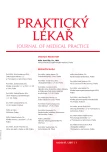Paracetamol poisoning
Authors:
J. Hlušička
Authors‘ workplace:
Vedoucí: MUDr. Sergey Zakharov, Ph. D.
; Přednosta: prof. MUDr. Daniela Pelclová, CSc.
; Toxikologické informační středisko
; Kliniky pracovního lékařství VFN a 1. LF UK, Praha
Published in:
Prakt. Lék. 2017; 97(1): 38-40
Category:
Case Report
Overview
Paracetamol is a widely used analgesic, antipyretic. Frequent use is associated with a higher frequency of dosage errors. Easy availability of the drug makes it also a substance often used in self-harm attempts; unfortunately, it applies also in case of adolescents. A similar situation is also abroad. The toxic dose is in case of acute ingestion from 200 mg/kg, in case of risk patient groups even lower. At this dose, glutathione in liver is already not able to deactivate the toxic metabolite of paracetamol, which leads to the necrosis of hepatocytes. To diagnose it is crucial to determine the plasmatic concentration of paracetamol. The basic therapy is the antidote N-acetylcystein. Accidental or purposeful overdose is very common in the Czech Republic. Contrary to western countries, we do not yet implement measures to decrease the amount of intoxications. The first step in this regard is the campaign “Use paracetamol reasonably”.
Keywords:
paracetamol – intoxication – glutathione – N-acetylcystein – hepatotoxicity
Sources
1. Bateman DN. Limiting paracetamol pack size: has it worked in the UK? Clin Toxicol (Phila) 2009; 47(6): 536–541.
2. Hawton K, Bergen H, Simkin S, et al. Impact of different pack sizes of paracetamol in the United Kingdom and Ireland on intentional overdoses: a comparative study. BMC Public Health 2011; 11: 460.
3. Olson KR. (ed.) Poisoning and drug overdose. 6th ed. New York: McGraw-Hill 2012; 69–72.
4. TOXBASE® – britská toxikologická informační databáze obsahující aktuální informace o intoxikacích, jejich příznacích a léčbě. Dostupné z: https://www.toxbase.org/
5. TOXINZ® – novozélandská toxikologická informační databáze obsahující aktuální informace o intoxikacích, jejich příznacích a léčbě. Dostupné z: http://www.toxinz.com/
6. Ward MR, et al. Acetaminophen toxicity in children. Pediatrics 2001; 108: 1020–1024.
7. Zakharov S, Navratil T, Pelclova D. Suicide attempts by deliberate self-poisoning in children and adolescents. Psychiatry Res 2013; 20(1): 302–307.
Labels
General practitioner for children and adolescents General practitioner for adultsArticle was published in
General Practitioner

2017 Issue 1
Most read in this issue
- Paracetamol poisoning
- Risk factors of falls in hospitalized patients
- Multiple chemical sensitivity
- Duties of attending physician in assessing the health status for the purposes of disability, social security benefits and employment
